Colorado Voters Make Case to Block Trump From Ballot
A group of Colorado voters laid out its argument to the Supreme Court on Friday for why former President Donald J. Trump should be barred from the state’s primary ballot, contending that his actions leading up to the Jan. 6, 2021, attack on the Capitol amounted to an insurrection.
In a court filing embedded with photographs of rioters attacking the Capitol and tweets from Mr. Trump, the voters forcefully asserted that Mr. Trump had spurred a brazen attack on democracy, betraying his oath of office.
“As president, Trump swore to preserve, protect and defend the Constitution,” the voters’ brief said. It added, “Instead of peacefully ceding power, Trump intentionally organized and incited a violent mob to attack the United States Capitol in a desperate effort to prevent the counting of electoral votes cast against him.”
Mr. Trump’s lawyers asked the Supreme Court to intervene after Colorado’s top court declared him ineligible because it found that he had engaged in insurrection in his efforts to overturn the results of the 2020 election leading up to the Capitol riot.
The justices are expected to hear the case, Trump v. Anderson, No. 23-719, on Feb. 8, less than a month before Super Tuesday, when many states, including Colorado, hold their primaries.
The central issue in the case is the meaning of a clause in Section 3 of the 14th Amendment of the Constitution that was added in the wake of the Civil War. That language prohibits from holding office those “who, having previously taken an oath, as a member of Congress, or as an officer of the United States, or as a member of any state legislature, or as an executive or judicial officer of any state, to support the Constitution of the United States,” have “engaged in insurrection or rebellion against the same, or given aid or comfort to the enemies thereof.”
That prohibition can be lifted by a two-thirds vote in each chamber of Congress.
In their brief, the Colorado voters asserted that Mr. Trump, in his legal filing, had not fully wrestled with the core issue in the case: whether he engaged in insurrection.
In his brief, Mr. Trump focused on whether Section 3 applied to him, arguing that it did not because the clause did not explicitly include the president as among the officials. “The president is not an ‘officer of the United States’ as that term is used in the Constitution,” Mr. Trump’s brief said.
Lawyers for the Colorado voters pushed back against that interpretation.
“Section 3 does not give a free pass to insurrectionist presidents,” their brief said. “They are ‘officers’ because they hold an ‘office.’”
They added: “It would defy common sense to hold that Section 3 disqualifies every oath-breaking insurrectionist officer (down to postmaster or county sheriff) except the most powerful one — a former commander in chief.”
The brief focused heavily on the history of the amendment, describing how sparingly it had been used for over a century “because insurrection against the Constitution has been mercifully rare.”
They argued that Mr. Trump’s actions in the run-up to the attack on the Capitol amounted to insurrection.
“Trump refused to accept defeat,” the brief said. “Instead, Trump summoned and incited an angry crowd to attack the Capitol and disrupt the certification of his electoral defeat.”
After weeks of tweeting by Mr. Trump, it added, “on Jan. 6, Trump lit the fuse.”
“Knowing the risk of violence and that the crowd was angry and armed,” the brief continued, “Trump incited violence both explicitly and implicitly during his speech at the Ellipse.”
Interspersed throughout the brief were photographs of the Jan. 6 attack. One showed the exterior of the building in chaos as rioters rushed inside. Blue “Trump 2020” banners could be seen.
Another photo showed a man in a police uniform wincing in pain while wedged in a door frame. The accompanying description read, “The mob brutally and repeatedly crushed another witness, Officer Daniel Hodges, in a metal door frame while trying to breach an entrance to the Capitol.”
The filing also wove in images of Mr. Trump’s tweets after his election loss and in the weeks leading up to Jan. 6, including a Dec. 19 post in which Mr. Trump wrote, “Big protest in D.C. on January 6th. Be there, will be wild!”
The lawyers overlaid a timeline of Mr. Trump’s tweets with photos of the rioters storming the Capitol, and wrote that he “celebrated the violence.”
A reply by Mr. Trump, if he files one, is due on Feb. 5.


